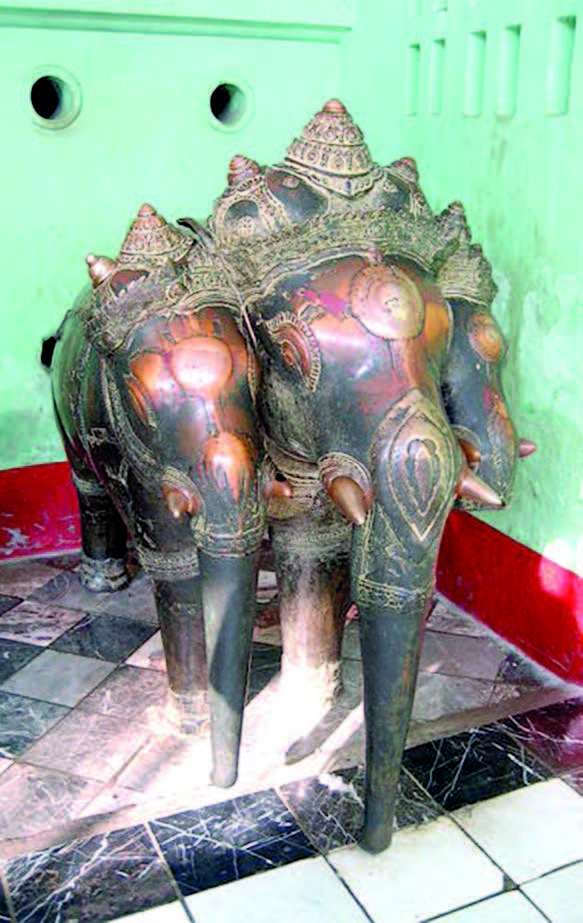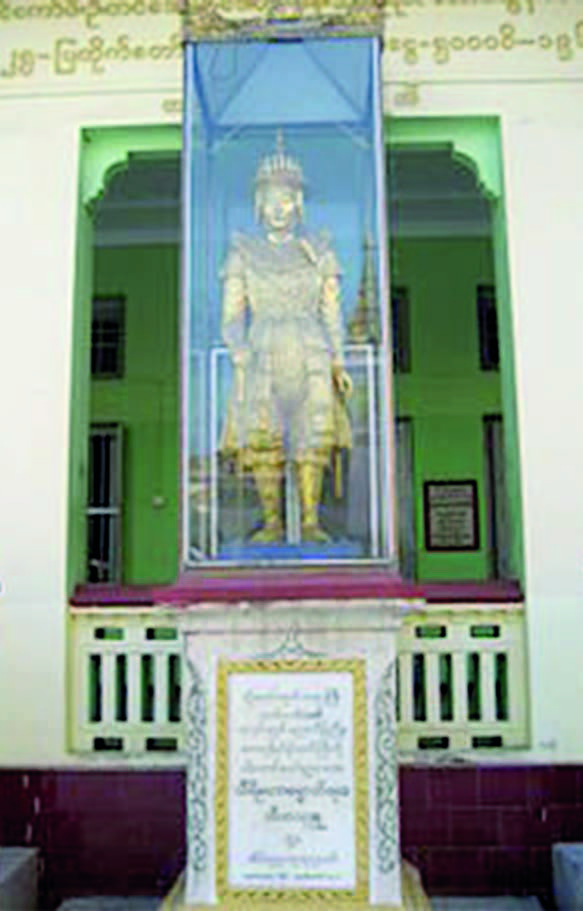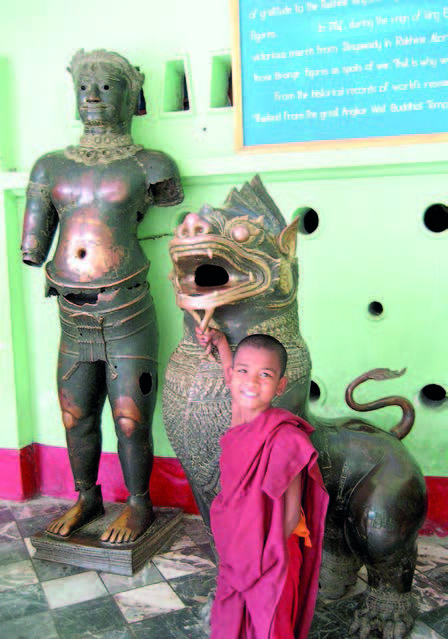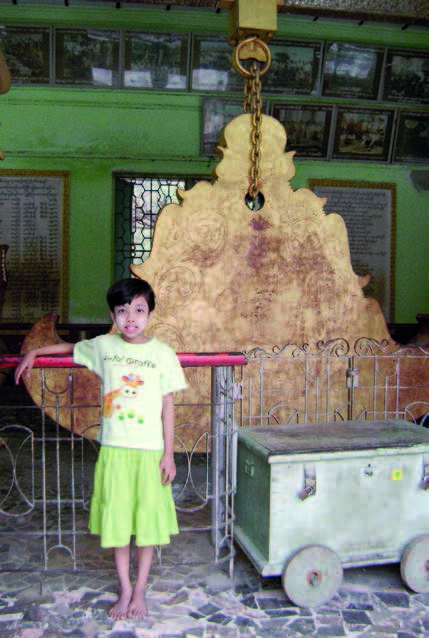February 29, 2020
By Maung Tha (Archaeology)
Maha Muni Buddha Image crowded with pilgrims from the morning to the evening on a daily basis is located in Kyunlon Okshaung Ward of Chanmyathazi Township in Mandalay. Its real title is Maha Muni.
Background history of Maha Muni
King Candasuriya of Rakhine ordered to cast a seven elbows, two mikes and two fingers (which are Myanmar measurement units) high bronze Buddha image. Kings of Danyawady in successive eras had paid homage to the Buddha image under the title of Maha Muni.
The Myanmar Encyclopaedia stated that King Anawrahta and King Alaungsithu tried to convey the Maha Muni Buddha image to Bagan but missions failed.

On 16 October 1784 mentioned in the Konbaung Dynasty Myanmar Dated History, 33 troops led by Maha Uparaja, son of King Bodawphaya, marched to Rakhine and occupied Danyawady on 2 January 1785. Maha Uparaja conveyed the image on 4 January 1785 after paying homage. The image arrived at Taungup jetty on 31 January 1785. Maha Uparaja ordered Secretary Naymyo Zeyathu to supervise conveyance of the image.
The Myanmar Encyclopaedia recorded that the image was conveyed from Myohaung to Taungup by raft and then continued conveyance of the image to Padaung along the jungle route by difficultly passing the mountain ranges. Afterwards, the image was conveyed abroad two rafts from Padaung jetty along Ayeyawady River. On 4 May 1785, the image arrived at Sagaing.
The Myanmar Encyclopaedia stated the original place of the image was five miles from opposite site of Kyauktaw in Rakhine State. A wealthy person U Ye Kyaw Thu built a Buddha image on the place.
Residence of Maha Muni
King Bodawphaya built a nine-tier building on the place, 1,000 tar north of the royal palace in Amarapura. The king, the first queen, ministers, court of counsellors and secretaries donated forehead of the image, crested headdress, stairways and public rest-houses respectively. Unfortunately, a fire which started outbreak in Yadana Bommi Ward on 7 April 1884 burnt the prayer hall and tier-roofed buildings down.
Despite destroying crested headdress, earplugs and sashes made of gold and gold foils, the outbreak of fire could not torch the image. In the incident, a record mentioned that melted gold in the fire weighing 5,450 could be collected but weighing unit was not mentioned.
A new crested headdress was decorated at Maha Muni Buddha Image on 23 June 1884. King Thibaw ordered to offer 60-viss gold plates made of melted gold in the fire to the image on 16 January 1885. Since then, the image is 12 feet and seven inches high and its throne, seven feet high.

Maha Muni Image at present
The existing tier-roofed building was built of bricks and concrete in 1260 Myanmar era. The umbrella hoisted atop the tier-roof of the building fell on the ground in strong winds in 1278 ME. So, Yaksawk Chieftain hoisted a new umbrella atop the building. Members of the Sudhamma Sangha led by Taungtaw Sangharaja took responsibilities for management of the image while laypersons led by Kinwun Minister served for all management functions. Shweyay Hall Abbot U Nanda was assigned with entrusting a key for the Gandakuti chamber to serve duty of cleansing the face of the image as of 1248 ME. Starting from 1st waxing of Tabaung 1349 ME, Abbot Bhaddanta Pannavamsa from Pitakat building of Taunghtilin Monastery served duty of cleansing the face of the image every morning.
The first financial supervisory committee for the image was formed in 1891. The Engineering Commissioner, the Assistant Engineer and Clerk laid cornerstones for the Gandakuti Chamber for the image on 27 June 1894. Under the supervision of Kinwun Minister, European architects enveloped the old Gandakuti Chamber by the new one in 1896. The outer brick monastery named Suvanna Maha Pasada which was completed construction on 18 January 1898 was hoisted an umbrella.
U Pe repaired the throne and backdrop of the image on 12 February 1900. He repaired the crested headdress donated by King Thibaw and offered a new one shaped with 940 pieces of jewellery to the image on 20 February 1902. The image was decorated with a gold sash made of nine great gems weighing 13.6 viss on 12 July 1908. Nyaungshwe Chieftain Sir Maung Tay donated a 19-tical diamond orb and the pennant-shaped vane atop the image in 1918.
As to increasing number of pilgrims to the image, hermit U Khanti built a brick stairway between the image and Ananda Ordination Hall on 29 January 1931. In commemoration of the 2,500th anniversary of the Theravada Buddhism, venerable abbots of Sankin, Nyaungyan, Khemathiwun and Hanthawady laid cornerstones for construction of Yadana Beikman building in 1956 and commissioned it into service on 14 April 1957. The wooden backdrop of the image was repaired in 1932-33.
More than 30 members of the Sangha led by U Jotika safeguarded objects of the image at the prayer building from 1942 to 1948. The bronze statue of Maha Uparaja who conveyed the image from Rakhine was cast in 1948 in order to display it in the precinct of the image. A central tower to mark the centennial anniversary of founding Yadanabon Royal Palace in Mandalay was built at the northeast corner of the platform of the image on 28 May 1959. A large bronze drum named Nyein-chan-tha-yar weighing 3,264 viss was cast on 31 December 1965. Moreover, a bronze gong named Chan-aye-pyi-thar weighing 2,156 viss was cast in 1972.

Two human statues, three lion statues and Eyawun elephant statue with three heads made of bronze can be seen in the precinct of the image. These statues were brought along with the image from Rakhine.
These bronze statues were taken by King Bayintnaung from Yodaya. After that, King Nanda, son of King Bayintnaung clashed with governor of Toungoo but the latter conquered King Nanda in the war. Governor of Toungoo gave these bronze statues as gifts to the king of Rakhine who helped Toungoo governor in the war, according to the Myanmar Encyclopaedia.
After conquering Yodaya, King of Hanthawady Bayintnaung Kyawhtin Nawrahta arrived back in Bago on 18 May 1564, according to the second volume of New Thwinthin History. These statues brought by King Bayintnaung were in Rakhine when Hanthawady Royal Palace ruined and returned to Amarapura Royal Palace in Konbaung era.
A total of 30 bronze statues brought along with Maha Muni image were kept in the ordination hall donated by Siri Sucanda Devi, wife of Yintaung city governor, at southeast of the precinct of the image. It was reported that some statues were damaged in collapse of at the red ordination hall called the tier-roofed building of Ananda Pagoda while these statues were kept in the yard of the hall.
Some said these statues were from Angkor City of Cambodia, two human statues of which were portrayed for Yodaya King Pyathadipati and his queen. But some said these statues were portrayed for gods of Yodaya. These statues are of male. Some pilgrims assume that if those who touch and massage these statues, they will be healthy.

Maha Muni Buddha image was built in cross-legged sitting posture with Bhumiphassa Mudra. The bronze image weighs 6.5 tons with 12 feet and seven inches in height, six feet in width between the two shoulders and 9.5 feet in width at the waist. It was reported that gold foils donated by Buddhists to the image reaches about six inches in thickness.
Homage and offering of Buddhist people helps ensure magnificent existence of Maha Muni Buddha Image throughout its history till today. Maha Muni in Pali language means a great noblest Lord Buddha in English. Being a religious, ancient image, Maha Muni Buddha Image is sure to be existence for many years thanks to preservation and renovation of Myanmar people in successive eras. (Translated by Than Tun Aung)
Reference:
Myanmar Encyclopaedia, Volume VIII
Chronicle of Mandalay’s Maha Muni Buddha Image (U Maung Maung Tin)
Konbaung Dynasty Myanmar Dated History (U Tikkhadhammalankara, Dr Than Tun)



